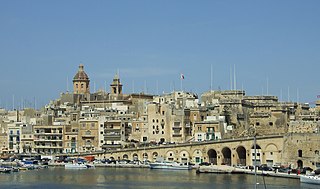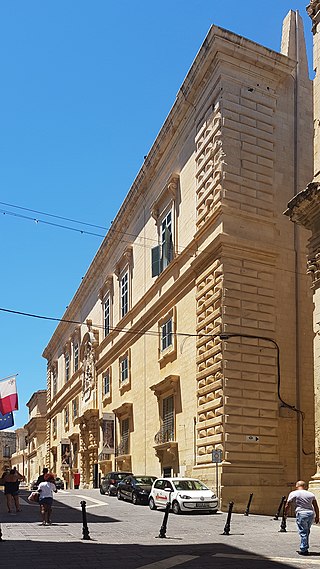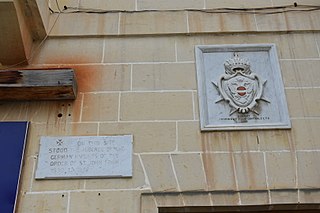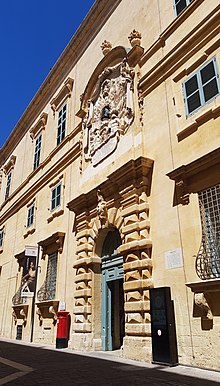
Birgu, also known by its title Città Vittoriosa, is an old fortified city on the south side of the Grand Harbour in the South Eastern Region of Malta. The city occupies a promontory of land with Fort Saint Angelo at its head and the city of Cospicua at its base. Birgu is ideally situated for safe anchorage, and over time it has developed a very long history with maritime, mercantile and military activities.

St John's Co-Cathedral is a Roman Catholic co-cathedral in Valletta, Malta, dedicated to Saint John the Baptist. It was built by the Order of St. John between 1573 and 1578, having been commissioned by Grand Master Jean de la Cassière as the Conventual Church of Saint John.

The Auberge d'Aragon is an auberge in Valletta, Malta. It was built in 1571 to house knights of the Order of Saint John from the langue of Aragon, Navarre and Catalonia. It is the only surviving auberge in Valletta which retains its original Mannerist design by the architect Girolamo Cassar.

The Grandmaster's Palace, officially known as The Palace, is a palace in Valletta, Malta. It was built between the 16th and 18th centuries as the palace of the Grand Master of the Order of St. John, who ruled Malta from 1530 to 1798, and was also known as the Magisterial Palace. When the knights were expelled by Napoleonic France, it became the National Palace. During the period of British rule beginning in 1800, it was the Governor's Palace.

The Auberge de Castille is an auberge in Valletta, Malta. The auberge is located at Castile Place, close to Saint James Cavalier, the Malta Stock Exchange, and the Upper Barrakka Gardens. It sits at the highest point of Valletta and overlooks Floriana and the Grand Harbour area.

Auberge de Provence is an auberge in Valletta, Malta. It was built in the sixteenth century to house knights of the Order of Saint John from the langue of Provence. It now houses the National Museum of Archaeology.

Auberge d'Allemagne was an auberge in Valletta, Malta. It was built between 1571 and 1575 to house knights of the Order of Saint John from the langue of Germany.

Auberge de France refers to two auberges in Valletta, Malta. They were both built in the 16th century to house knights of the Order of Saint John from the langue of France, which induced the entire Kingdom of France except for Auvergne and Provence which were separate langues.

The Auberge d'Auvergne was an auberge in Valletta, Malta. It was built in the 16th century to house knights of the Order of Saint John from the langue of Auvergne. It became a courthouse in the 19th century, and it remained so until it was destroyed by aerial bombardment in 1941. The site is now occupied by the Courts of Justice building, which was constructed in the 1960s.

The Auberge de Bavière is a palace in Valletta, Malta. It was built as Palazzo Carneiro in 1696, and it was the residence of Grand Master Marc'Antonio Zondadari in the early 18th century. In 1784, it was converted into the auberge for the Anglo-Bavarian langue of the Order of Saint John, and it remained so until the French occupation of Malta in 1798.

The Auberge d'Italie is an auberge in Valletta, Malta. It was built at various stages in the late 16th century to house knights of the Order of Saint John from the langue of Italy, and it originally had a Mannerist design by Girolamo Cassar and several other architects. The building continued to be modified throughout the course of the 17th century, with the last major renovation being carried out in the 1680s during the magistracy of Gregorio Carafa, giving the building a Baroque character.
Girolamo Cassar was a Maltese architect and military engineer. He was the resident engineer of the Order of St. John, and was admitted into the Order in 1569. He was involved in the construction of Valletta, initially as an assistant to Francesco Laparelli, before taking over the project himself. He designed many public, religious and private buildings in the new capital city, including Saint John's Co-Cathedral, the Grandmaster's Palace and the auberges. He was the father of Vittorio Cassar, another architect and engineer.

The Auberge d'Allemagne was an auberge in Birgu, Malta. It was built in the 16th century to house knights of the Order of Saint John from the langue of Germany.

The Auberge d'Italie was an auberge in Birgu, Malta. It was built in the sixteenth century to house knights of the Order of Saint John from the langue of Italy.

Auberge d'Angleterre is an auberge in Birgu, Malta. It was built in around 1534 to house knights of the Order of Saint John from the langue of England. It now houses a health centre, and it is the best-preserved Hospitaller auberge in Birgu.

The Auberge d'Aragon is an auberge in Birgu, Malta. It was built in the 16th century to house knights of the Order of Saint John from the langue of Aragon, Navarre and Catalonia.

Auberge d'Auvergne et Provence is an auberge in Birgu, Malta. It was built to house knights of the Order of Saint John from the langues of Auvergne and Provence.

Auberge de France is an auberge in Birgu, Malta. It was built in around 1533 to house knights of the Order of Saint John from the langue of France, which induced the entire Kingdom of France except for Auvergne and Provence which were separate langues. The building housed the French langue until a new Auberge de France was opened in Valletta.

The Auberge de Castille et Portugal was an auberge in Birgu, Malta. It was built to house knights of the Order of Saint John from the langue of Castille, León and Portugal.

Maltese Baroque architecture is the form of Baroque architecture that developed in Malta during the 17th and 18th centuries, when the islands were under the rule of the Order of St. John. The Baroque style was introduced in Malta in the early 17th century, possibly by the Bolognese engineer Bontadino de Bontadini during the construction of the Wignacourt Aqueduct. The style became popular in the mid to late 17th century, and it reached its peak during the 18th century, when monumental Baroque structures such as Auberge de Castille were constructed.


























